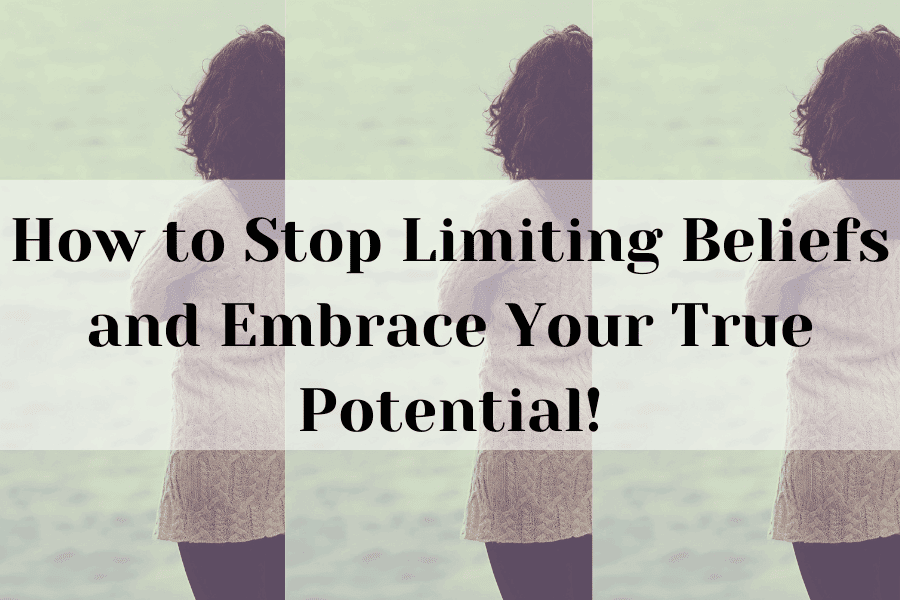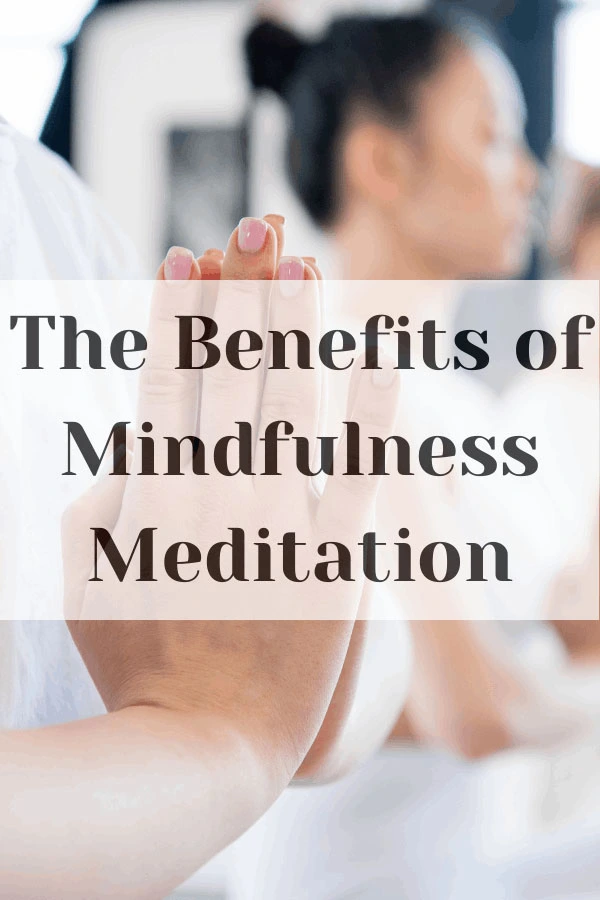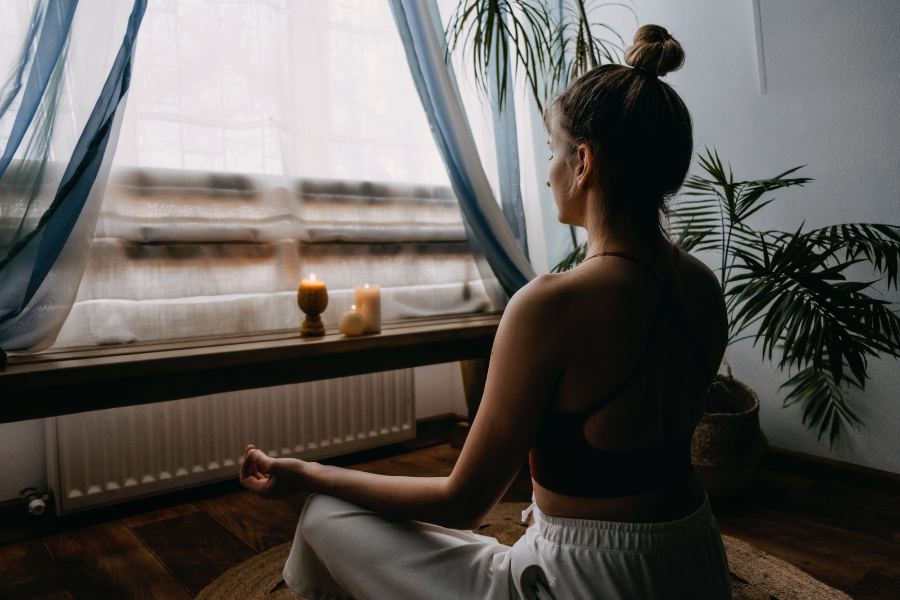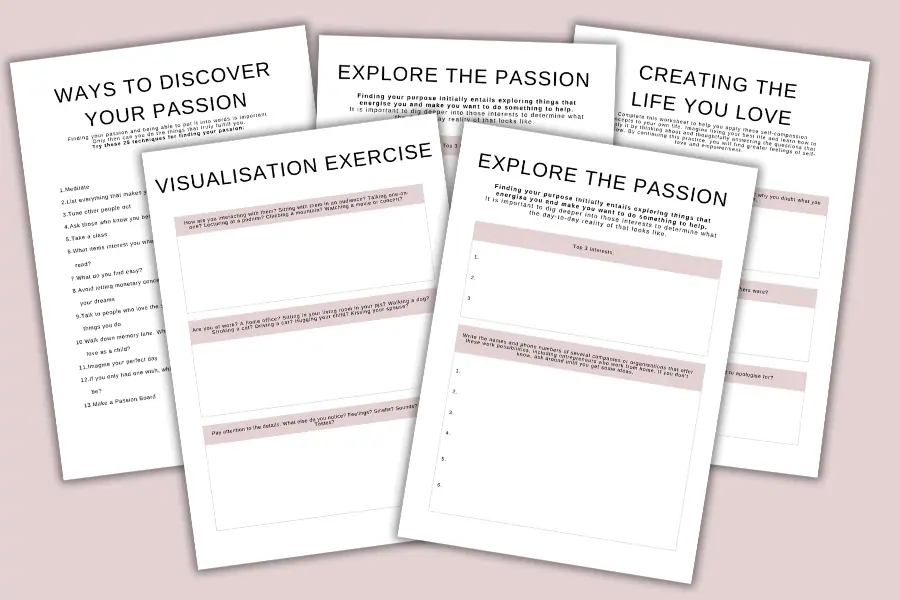How to Stop Limiting Beliefs and Embrace Your True Potential!

We all have thoughts and beliefs that shape how we see ourselves and the world around us, learning how to stop limiting beliefs can be life-changing!
While some beliefs can empower and uplift us, others can become obstacles that hinder our growth and potential.
They are the self-imposed barriers that hold us back from achieving our goals and living our best lives.
This post is about how to stop limiting beliefs

What Are Limiting Beliefs?
Limiting beliefs are those deeply ingrained thought patterns and beliefs that create doubts and negative self-perceptions.
They are the “I can’t,” “I’m not good enough,” or “I’ll never succeed” kind of thoughts that seem to pop up when we dare to pursue our dreams or step outside of our comfort zones.
How can limiting beliefs hold us back?
Limiting beliefs act as invisible chains that keep us confined to our comfort zones and prevent us from exploring our true potential.
They create fear, self-doubt, and insecurity, leading us to shy away from taking risks or seizing opportunities.
By clinging to these beliefs, we unwittingly undermine our self-confidence and limit our capacity to achieve greatness.
Learning how to stop limiting beliefs can be the key to your success.
The negative impact
Limiting beliefs can infiltrate every aspect of our lives, from personal relationships to professional pursuits.
In personal relationships, they may lead to a fear of rejection, causing us to build walls and avoid vulnerability.
In our careers, they may hinder us from pursuing promotions or new challenges, keeping us stuck in unfulfilling roles.
These beliefs can also affect our mental health, causing stress, anxiety, and even depression as we perpetuate a cycle of negativity.
They might impact our physical health as well, as the constant stress and self-criticism take a toll on our well-being.
In summary, limiting beliefs are powerful psychological barriers that prevent us from realising our full potential and can negatively impact our personal and professional lives.
The good news is that we have the ability to stop these limiting beliefs.
By doing so, we can unlock our true capabilities and embrace a more fulfilling and rewarding life.
Identifying Limiting Beliefs
Recognising and understanding your own limiting beliefs is a crucial step towards breaking free from their grip and achieving personal growth.
Let’s dive into how you can identify these beliefs, common examples people might face, and how they may have developed over time.
How to recognise your limiting beliefs
Identifying your limiting beliefs begins with self-awareness.
Pay attention to your inner dialogue and thought patterns, especially when you encounter challenges or set new goals.
Notice any recurring negative thoughts or feelings of self-doubt.
Ask yourself why you might be hesitating or holding back in certain situations.
Keeping a journal can be immensely helpful.
Write down your thoughts and emotions as you navigate different situations.
By documenting your inner experiences, you can gain valuable insights into the patterns and beliefs that influence your behaviours.
Common limiting beliefs
While limiting beliefs can vary from person to person, there are some common themes that many people encounter:
“I’m not smart/talented enough”: Feeling inadequate or not intelligent enough to pursue certain opportunities or passions.
“I don’t deserve success/happiness”: Believing that you’re unworthy of achieving your goals or experiencing joy.
“I’m too old/young”: Using age as an excuse to avoid taking risks or making changes.
“I’m not good with people”: Assuming you lack the social skills needed to build meaningful relationships or succeed in social settings.
“I’ll never be as good as others”: Constantly comparing yourself to others and believing you’ll never measure up.
How limiting beliefs evolve
Limiting beliefs often stem from past experiences, childhood upbringing, and societal influences.
Negative feedback or criticism during childhood might lead to a persistent sense of inadequacy.
Traumatic events can also shape beliefs about personal safety and worth.
Furthermore, societal norms, cultural expectations, and media portrayals can perpetuate limiting beliefs.
Messages such as “success is only for the exceptionally talented” or “you can’t change who you are” can seep into our subconscious minds and shape our beliefs about what we can achieve.
Over time, these beliefs become ingrained, and we develop cognitive biases that reinforce them.
Our minds filter information in a way that confirms these beliefs, further solidifying their hold on us.
By understanding the roots of our limiting beliefs, we can begin to challenge their validity and consider alternative perspectives.
This awareness empowers us to break free from the constraints of these beliefs and take steps towards personal transformation.
The Power of Awareness
Becoming aware of your limiting beliefs is a pivotal first step in the journey of personal growth and self-improvement.
By shining a light on these deeply ingrained thought patterns, you gain the opportunity to challenge and transform them.
Let’s explore why awareness is crucial, how self-awareness can liberate you from limiting beliefs, and practical exercises to enhance your self-awareness.
Becoming aware
Awareness is the key that unlocks the door to change.
Many people operate on autopilot, unaware of the negative beliefs that dictate their actions and decisions.
When you become conscious of these limiting beliefs, you take control of your thought processes and emotional responses.
Awareness empowers you to examine the accuracy of these beliefs and decide whether they truly align with your values and aspirations.
Breaking their hold
Self-awareness is the foundation upon which personal growth is built.
By cultivating a deep understanding of your thoughts, emotions, and behaviours, you can identify patterns and triggers associated with your limiting beliefs.
This heightened awareness allows you to catch self-limiting thoughts as they arise, preventing them from spiralling into self-sabotage.
Moreover, self-awareness fosters compassion for yourself.
Instead of harshly judging yourself for having limiting beliefs, you can approach them with curiosity and understanding.
This compassionate mindset creates a safe space to explore and challenge these beliefs without self-criticism.
How to enhance your awareness
Mindful journaling
Set aside time each day to write in a journal, expressing your thoughts and feelings without judgment.
Reflect on your experiences, interactions, and any negative thought patterns that emerge.
Observe how these thoughts impact your emotions and behaviours.
Meditation
Regular meditation practice allows you to observe your thoughts from a detached perspective.
As you meditate, let thoughts come and go, without attaching to them.
This practice strengthens your ability to recognise thought patterns and limiting beliefs as passing mental events.
The ‘5 Whys’ techniques
Whenever you encounter a self-limiting belief, ask yourself “why” it feels true.
Continue asking “why” five times to delve deeper into the root cause of that belief.
This technique helps reveal the underlying assumptions and experiences that contribute to the belief’s hold on you.
Seeking feedback
Ask close friends or family members to provide honest feedback about your behaviours and attitudes.
Their insights can offer an external perspective on your thought patterns and beliefs that you may not have noticed on your own.
By consistently practising self-awareness exercises, you strengthen your capacity to recognise and challenge limiting beliefs.
As you progress through this journey of self-discovery, you’ll gain the freedom to reshape your beliefs, break free from self-imposed limitations, and embrace a life of endless possibilities.
Challenging Limiting Beliefs
To overcome limiting beliefs, it’s essential to challenge their validity and replace them with empowering alternatives.
Here are effective strategies to help you challenge your limiting beliefs, confront negative thoughts, and embrace evidence-based thinking to foster personal growth and resilience.
Strategies to challenge limiting beliefs
The reality challenge
Ask yourself if there is concrete evidence supporting your limiting belief.
Often, these beliefs lack objective evidence and are based on assumptions or past experiences that no longer apply.
Challenge yourself to find evidence that contradicts the belief or supports a more positive perspective.
Consider alternative explanations
Explore alternative explanations for situations that trigger your limiting beliefs.
Look for instances where the opposite of your belief might be true or where your belief doesn’t hold up.
Thought record
Keep a thought record where you write down your negative thoughts and the situations triggering them.
Challenge these thoughts by questioning their accuracy and exploring more balanced or positive perspectives.
Challenge limiting beliefs
Recognise thought distortions
Many of us unknowingly fall into cognitive distortions, where our thoughts become exaggerated or biased.
Common distortions include all-or-nothing thinking (seeing things in black and white), catastrophising (expecting the worst outcome), and personalisation (assuming everything is about us).
Reframe self-talk
The way we talk to ourselves has a profound impact on our beliefs and actions.
Negative self-talk can reinforce limiting beliefs and erode self-confidence.
As a remedy, practice self-compassion and replace negative self-talk with constructive and supportive language.
For example, rather than saying, “I can’t do this; I always fail,” reframe it to “I can learn from past experiences and improve with effort.”
By reframing self-talk, you create a positive and nurturing inner dialogue that helps challenge the validity of limiting beliefs.
Celebrate progress
In the pursuit of personal growth, it’s crucial to celebrate progress, no matter how small.
Acknowledge your achievements and milestones along the way.
Each step taken towards positive change challenges the hold of limiting beliefs.
Personal growth is a journey, and perfection is not the goal.
By embracing progress, you foster resilience and build confidence in their ability to overcome limiting beliefs.
Evidence-based thinking and reframing thoughts
Evidence-based thinking
Beliefs based on assumptions or emotions can be unreliable and limiting.
Instead, focus on evidence-based thinking.
Critically evaluate your beliefs and seek objective observations and data to support or challenge these beliefs.
Reframing thoughts
Reframe your negative thoughts into more positive and constructive statements.
This process involves consciously replacing negative words and interpretations with empowering and realistic ones.
For instance, if you think, “I’m not good enough to apply for that job,” you can reframe it as “I have valuable skills and experiences that make me a strong candidate, and I can learn and grow in this role.”
By reframing thoughts, you can transform self-doubt into self-assurance and challenge your limiting beliefs.
Affirmations and visualisation
Use of positive affirmations and visualisation techniques to reinforce new beliefs.
Repeat affirmations regularly, such as “I am capable and worthy of success,” to build a positive self-image.
Visualisation can complement affirmations by vividly imagining yourself overcoming challenges and achieving your goals.
Mindfulness Meditation
Mindfulness meditation is a powerful practice that can be a game-changer in our journey to stop limiting beliefs from holding us back.
Rooted in ancient contemplative traditions, mindfulness meditation has gained popularity in recent years due to its scientifically proven benefits for mental and emotional well-being.
What is mindful meditation?
At its core, mindfulness meditation is about being present in the moment, without judgment or attachment to thoughts and feelings.
It involves intentionally directing our attention to the present experience, whether it’s the sensations of our breath, the sounds around us, or the sensations in our body.
Through consistent practice, mindfulness cultivates a non-reactive and non-judgmental awareness of our thoughts and emotions.
Impact on challenging limiting beliefs
Mindfulness meditation plays a vital role in addressing limiting beliefs by increasing self-awareness and promoting a compassionate relationship with ourselves.
When we practice mindfulness, we become more attuned to our thought patterns and can identify the recurring negative thoughts that reinforce limiting beliefs.
By observing these thoughts without judgment, we create space to challenge their validity and break free from their hold on us.
Mindfulness meditation also helps us develop emotional regulation and resilience.
Instead of getting carried away by distressing emotions triggered by limiting beliefs, we learn to acknowledge and process them with a sense of detachment.
Practical techniques for mindfulness meditation
Breath awareness
One of the simplest mindfulness techniques involves focusing on the breath.
Find a quiet space, sit comfortably, and bring your attention to the sensations of the breath as it flows in and out.
Whenever your mind wanders, gently bring it back to the breath without judgment.
Body scan
Lie down or sit comfortably and slowly scan your body from head to toe, paying attention to any physical sensations or areas of tension.
This technique promotes relaxation and a deeper connection with the body-mind connection.
Loving-kindness meditation
Cultivate feelings of compassion and love towards yourself and others through loving-kindness meditation.
Repeat phrases like “May I be happy, may I be safe, may I be free from suffering” while directing these well-wishes towards yourself, loved ones, and even challenging individuals.
Mindful daily activities
Practice mindfulness in everyday activities like eating, walking, or washing dishes.
Pay attention to each movement and sensation without rushing or being distracted by thoughts.
Mindfulness meditation is a profound tool for liberating ourselves from limiting beliefs and cultivating a greater sense of clarity, presence, and self-compassion.
By integrating mindfulness into our lives, we foster self-awareness, emotional resilience, and a deeper understanding of our thought patterns.
As we embrace the practice of mindfulness, we open ourselves to the possibility of a more authentic and fulfilling existence, free from the shackles of limiting beliefs.
Setting Realistic Goals
In our quest to stop limiting beliefs from hindering our progress, setting realistic goals and taking decisive action is a crucial part of the journey.
This section delves into the significance of setting achievable objectives and the power of taking proactive steps towards personal growth.
We’ll explore strategies for setting goals that challenge but don’t overwhelm, as well as the importance of perseverance and consistent effort.
The importance of setting realistic goals
When confronting limiting beliefs, setting realistic goals is like laying a strong foundation for a successful transformation.
Unrealistic or overly ambitious goals can fuel self-doubt and reinforce limiting beliefs.
Instead, set objectives that are challenging but attainable, reflecting your current abilities and resources.
SMART goals framework
When setting goals, use the SMART (Specific, Measurable, Achievable, Relevant, Time-bound) goals framework.
Specific goals provide clarity, measurable goals allow for progress tracking, achievable goals instil confidence, relevant goals align with your aspirations, and time-bound goals establish a sense of urgency.
For example, if someone’s limiting belief is “I’m not good enough to start my own business,” a SMART goal could be, “I will research and create a business plan for my dream venture within the next three months.”
Breaking down goals into smaller steps
Breaking down larger goals into smaller, manageable steps.
Taking bite-sized actions reduces feelings of overwhelm and instils a sense of accomplishment with each completed step.
This approach helps to challenge limiting beliefs by proving that progress is possible.
The power of taking action
Taking action is a transformative force in dismantling limiting beliefs.
Even small actions in the direction of your goals challenge the grip of limiting beliefs and strengthen your self-belief.
Embracing perseverance and consistency
This process requires perseverance and consistent effort.
Setbacks and challenges are inevitable, but each one presents an opportunity to learn and grow.
Things happen for you, not to you!
Setting realistic goals and taking action are pivotal steps on the path to overcoming limiting beliefs and embracing personal growth.
Through consistent action, you challenge the self-imposed limitations that have held you back, replacing doubt with determination.
As you persevere through challenges, you’ll witness the transformative power of action and the gradual fading of limiting beliefs.
Ultimately, by setting your sights on achievable objectives and boldly taking steps towards them, you can break free from the confines of limiting beliefs and unlock boundless potential.
Final thoughts!
In the quest to stop limiting beliefs from overshadowing our potential, we’ve explored a range of empowering strategies and mindsets.
From identifying and understanding limiting beliefs to cultivating empowering thoughts through mindfulness meditation.
Each step is a vital piece of the puzzle for personal growth and self-discovery.
Yet, it is essential to recognise that change is a process that requires patience and resilience.
Challenges and setbacks may arise, but we’ve learned to view them as stepping stones, guiding us towards greater growth and self-discovery.
Perseverance and consistency become our allies, transforming limiting beliefs into stepping stones rather than barriers.
As we conclude this journey of self-discovery, let’s remember that the power to stop limiting beliefs lies within us.
Through mindfulness, self-awareness, support, and action, we uncover the strength and courage to rise above self-imposed limitations.
Our minds become sanctuaries of positive and empowering beliefs, replacing doubts with a newfound sense of possibility.
This post was about how to stop limiting beliefs
Share this post: on Twitter on Facebook





